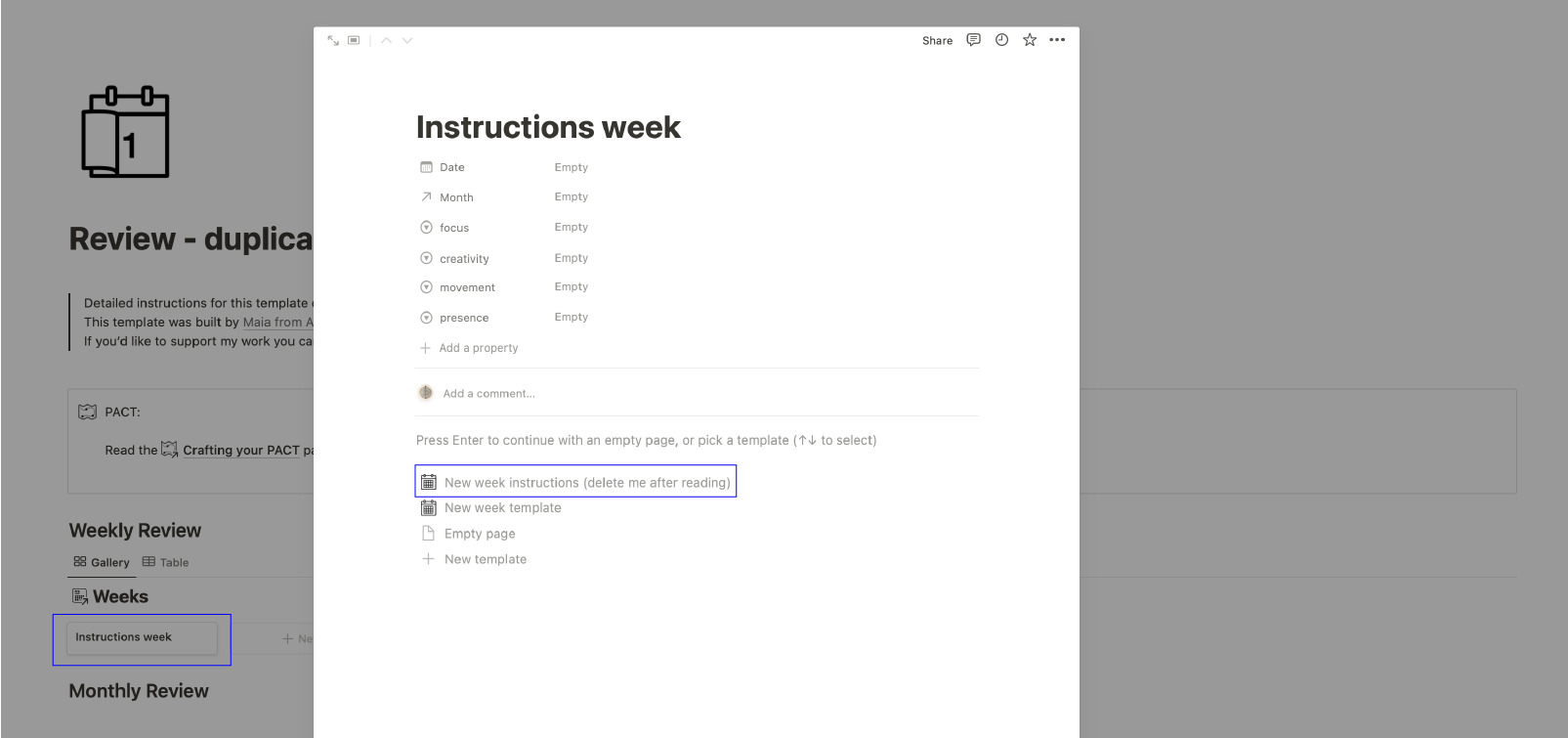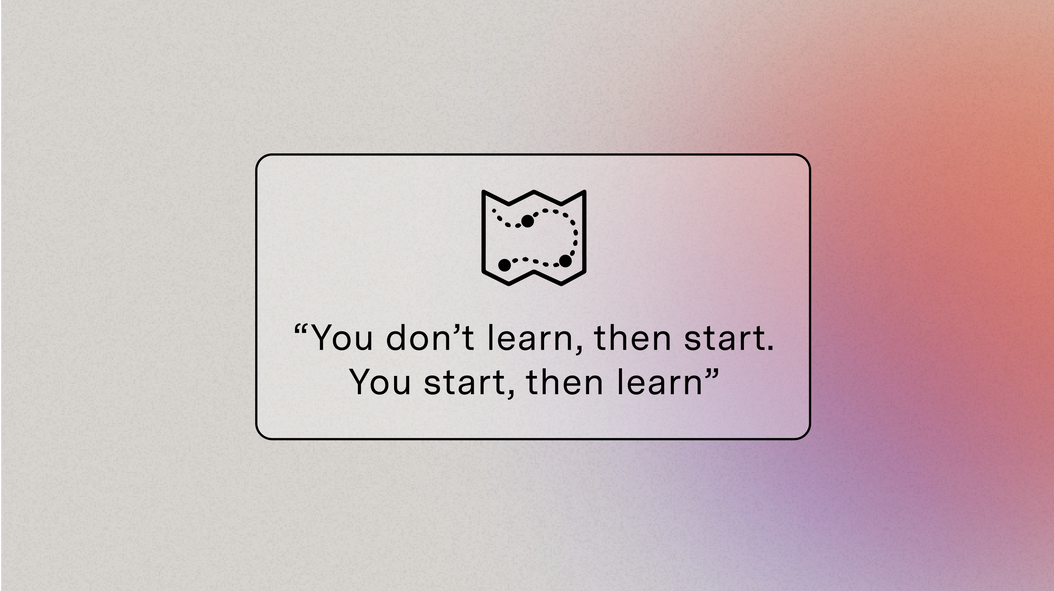The secret to performing actions that align with your long-term vision is understanding yourself deeply. It took me more than twenty years to realize that.
Cultivating a powerful introspection practice and creating a weekly review ritual has driven the most significant change in my life, helping me transform intention into action.
This template will allow you to build the road that drives you towards your vision, and through using it you might find out you want to re-build the vision itself.
This is always a good sign: re-invention.
What is a weekly review and reflection ritual?
Simply put, it is the practice of reflecting and evaluating what is working and what is not.
And I call this template a review and reflection, because its built to make you reflect not only on the what, but on the why and how: why are those systems working/not working, and how do they make you feel.
Finding the root "why"
The most efficient way to get to your goals is understanding why you're not there yet.
Finding the root cause of your procrastination is an incredible by-product of self-reflection. You can practice every single techniques to break procrastination, but if you don’t know the core reason of why you’re stuck, these techniques will fade eventually.
Without self-reflection, generic systems won't work because the underlying cause of your procrastination is still there. You’re taking a pain killer instead of dealing with the source.
Self-reflection rituals work because you're not alleviating the symptoms, you're finding the root problem and understanding it, helping you deal with it holistically instead of putting a band-aid on it.
The true power of self-reflection
So how can a simple thirty minute practice once a week work so miraculously? Because it works holistically: every element in it is connected with the next. All elements together create a feedback loop that reveals the changes you need to implement in your life. You're able to create growth loops, and the only thing you need to do is: reflect.
You'll benefit from a weekly review and reflect ritual if you want to:
- Build and sustain systems to achieve your goals.
- Understand the common patterns that repeat week after week.
- Learn about yourself and align your daily actions to your long-term aspirations.
- Visually understand what areas of your life need more focus.
- Live a more meaningful life by cultivating self-curiosity.
- Cultivate an introspection practice that sticks.
Instructions + the template
This is a Notion template, which is a free tool. New to Notion? Buckle up, it will change your whole life.
Once you've duplicated your template in the top right corner of the page, it will live in your own Notion workspace. You can drag, re-arrange, add, and delete anything to suit your needs.
To begin, click on the "instructions week" box under "weeks".
Once you click on it you will see the "instructions week" page pop up. Click on the "New Week instructions" template and read through it.

This page will walk you through the pieces of the weekly review. Feel free to delete it after you're familiar with it. You can delete the page on the three dots at the top right corner.

To add a new week and fill it in, click on the "+new" box under weeks.

Once the week page pops up, click on "new week template".
Note: if you're familiar with Notion feel free to click on "empty page" or "New Template".
Name your week: you can add a simple name like dec 1 - dec 7, use one word to describe your week, add an emoji, whatever feels intuitive. Click the date box to add the dates of the week.
Month: since you haven't created any months, the template will suggest you to create a new month. Write the name of the month and year.
Tracker: I track focus, creativity, presence and movement. You can change these metrics to anything you want. I explain how to customize the template at the end of the article.
Filling your week
The weekly Review & Reflect is divided in three parts: past, present and future.

The past section is a time and task audit. Pull out your to-do list, calendar or task manager from the past week and answer the questions. The prompts are there to give you a direction, but feel free to do some free-flow journaling if you prefer that form of introspection. Focus on finding the core "why" of your highs and lows.

The present section allows you to reflect on your Pact. To craft yours, click on the crafting your pact page. It shouldn't take you more than 15 minutes. The final version of your pact will sync in here and you'll be able to see it in every review.
This section helps you understand if you are being constant with the actions that will bring in the most transformation in your life.
Did I commit to the things I wanted to do this week or not? If not, why? Find the why.

The future section is one of my favorite introspection tools. The plus minus next framework (created by Anne-Laure from Ness Labs) is a fast, flexible and future-forward to understand your highs, lows and next steps. It takes less than five minutes and it can bring so much clarity into your life.
The last part of the weekly review is looking at your "next" column, and scheduling those next steps into your calendar.
After going through these three sections you should have a better sense of how your last week went, how your emotional landscape looks like at the moment, and where you want to go next week.
All under thirty minutes, once a week.
Tying it all together: patterns.
After a few weeks of "data", something incredible will happen: you will start to become aware of patterns. This is when the magic begins: you gain the power to create growth loops thanks to your introspection practices.
Monthly review
The monthly review is a space to observe these patterns, reflect on your past weeks and write down any conclusions that you can think of.
It is also a good time to look at your pact and reflect if it needs tweaking, or if its helping you walk towards your goals.
This is completely up to you: I personally do reviews weekly, monthly and yearly. The weekly helpes me focus on systems, monthly review helps me with progress, and vision. The yearly review is a chance to reflect on the bigger picture.

To add a new month click on the "add new month" box. The month prompts are more flexible since they're meant to make you reflect on your long-term vision, and notice patterns through journaling.
A quick journaling exercise I like to do at the beginning of each month is: what am I calling in, and what am I letting go. It's a simple way to scan what you want, and what you don't want.
As I said before, the prompts are there to give you a direction, but feel free to free-flow journal.

Important: don't forget to link the weeks of the month so you can see the metrics you've tracked the past weeks (creativity, focus, movement and presence in my case.)
Yearly review
We are close to the end of the year and for us productivity freaks this is the real christmas present: the yearly review ritual! If you're subscribed to the newsletter you will receive an update of this template with the yearly review prompts that I've been using.
My yearly review this year will be different. In 2023 I am not setting goals, I am setting intentions. More on that in the following weeks, for now feel free to populate the yearly review with your own propmpts and goals since I know it's a personal ritual for many of us.
And if it's not, I hope this template landed in your hands just in time to want to start one.

How to customize your template
There's a million ways you can make Notion customizable, if you're interested in the aesthetic part of the template I recommend you to look at tutorials and widgets online.
If you want to make the metrics, prompts and the inside of each week customizable, you need to customize the template inside the page.

Click on the week, month or year page and click on the three dots next to the templates, and select "edit this template".
In there you can delete the sections that you don't want, re-write the prompts, or add your own sections that you will use every week/month/year.
You can also select "new template" and create your own weekly review from scratch.
It is important if you're starting this practice that you make it simple: start small so the habit sticks.
Lastly, know that this review is just a guide that will help you cultivate a self-reflection practice. It is meant to be flexible and customizable to your likes and needs. Remember, the best tools are the one that work for you; adjust and simplify it so it fits you.
Happy introspection time! And please email me with any questions and feedback and I am always trying to improve my templates.


